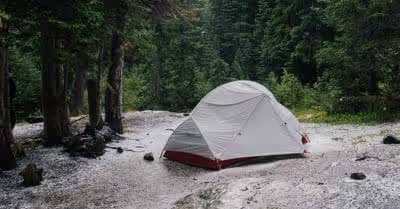Table of Contents
Why You Should Put Your Sleeping Pad In Your Sleeping Bag?
1. It Keeps It From Moving
A lot of times, when one finally calls it a day while camping, they spend a couple of minutes tossing and turning in their sleeping bag to comfort them. And when they finally do, they find that their sleeping pad keeps moving out from under them. This has happened to a whole lot of campers during their trips, and it may have even happened to you.
Since sleeping pads offer extra cushioning and warmth, having it slip out from under you can be uncomfortable and can't leave you feeling cold for the night. To avoid this, you can slip the pad into your sleeping bag to keep it from moving. In doing this, you'll still get all the extra cushioning you need to sleep on the hard ground, and you get to keep most of the insulation properties of your pad.
2. It Can Keep You Warmer
The insulation that sleeping pads offer works best when they are separated from the sleeping bag. However, if you are a person like me, and you move around a lot in your sleep, you might find yourself either rolling off the pad or moving the pad away from you. When that happens, you're left with nothing between the bag and the floor. And we all know how cold that can be.
By putting the pad in your sleeping bag, it will be impossible for the pad to slip out from under you. That way, you get all the insulation you need and you can stay warm through the cold forest night. And while you lose some insulation properties when the pad is inside the bag, the difference is very small and will barely be noticed.
3. It Can Make Camping With A Hammock Much Easier
Hammocks are great for camping, they're comfortable, easy to set up, and light to carry. However, since they are open at the back, a lot of heat can escape your body, leaving you feeling cold. After all, air is a very poor conductor of heat, so the way hammocks are designed will actually force your body to release heat, leaving you cold at night.
Because of this, a sleeping pad is essential when using a hammock. But if you've tried to fit a sleeping pad into a hammock before, you know that it's a pretty tough task. Aside from spending minutes on end trying to get the sleeping pad to fit just right, you will also have to worry about carefully getting into the hammock and not moving the pad away.
The best way to skip all this trouble is by putting a sleeping pad inside your sleeping bag. That way, staying on top of your pad and staying warm while camping in a hammock will be much easier.
4. It Can Protect Your Sleeping Bag
Over the years, inflatable sleeping bags have been growing in popularity. They are convenient to bring around and can be very comfortable when sleeping. That's why it's a favorite of experienced campers and hikers everywhere. That being said, if you use an inflatable bag long enough, chances are you'll end up puncturing it.
This is no one's fault, however. Campgrounds can be unpredictable and it's unavoidable for most people to move in their sleep. That is how sticks and thorns end up piercing sleeping bags and rendering them pretty much useless. Sleeping pads are one of the best ways to avoid this problem.
Again, by sticking your pad inside the sleeping bag, you create an extra layer in between you, the ground, and your sleeping bag. This offers a certain level of protection for the bag and can be a great way of maximizing the lifespan of an inflatable sleeping bag.
And even if it isn't inflatable, having the pad inside the bag will still protect against punctures that can totally ruin your sleeping bag and your camping experience.
Why You Shouldn't Put You Sleeping Pad Inside Your Sleeping Bag
Now that we've looked at the why's, it's time to look at the why not. Read on to learn more.
1. Most Pads Aren't Designed For That
Most sleeping pads on the market are designed to be placed under the sleeping bag, not inside it. Because of that, putting your sleeping pad in the bag can lead to some problems, especially with the more popular pads out there.
The more popular sleeping pads are designed to keep you as comfortable as possible. That's why they are bigger than other standard pads you can find on the market. Since they are bigger, some of them won't fit in a sleeping bag at all. However, if the pad is too big to fit in the bag, chances are these pads will be able to stay underneath you easier than the smaller ones.
2. You Lose Some Insulation
Sleeping bags are not the best insulators. When you lay down in one, the back of it compresses, allowing heat to escape from your body and go into the cold ground. That's why sleeping pads go under the bag, to serve as extra insulation between you and the ground, keeping you warm.
However, when you put the pad inside the bag, there is nothing in between the sleeping bag and the ground, which can leave you feeling a bit cold. And while that certainly is true, there isn't too much insulation lost when this is done. So that means you won't feel as warm as when the pad is on the ground, but you won't lose too much body heat by keeping the pad inside the bag.
Things To Consider When Putting A Sleeping Pad In A Bag
Now that we've gone over the pros and cons of putting your pad in a sleeping bag, it's time to look at the things to consider before you actually do it.
1. The Type Of Pad You Have
As mentioned above, some pads simply can't fit inside a sleeping bag. And if that's the case, you really shouldn't force it. Your only options at this point would be either to cut the bag or the pad to allow everything to fit, and that is less than ideal.
If you really want to put your sleeping pad inside the sleeping bag, you have to make sure that you get a pad that is small enough to fit in your bag. One popular option that's being used a lot is rolling the top end of the pad up when it's in the bag. That way, the sleeping pad will fit comfortably and the person using the bag will have a make-shift pillow to use while sleeping.
2. The Type Of Surface You're Sleeping On
Sometimes, if you're sleeping in a tent and you have a pad big enough for you, you won't need to slip the pad in. However, if you find yourself away from the pad in the middle of the night, you might want to consider putting it in your sleeping bag.
But if you're sleeping on a hammock, the best choice might be to put the pad inside. That's because it can be very hard placing a sleeping pad on a hammock and getting on it. If you're anything like me, you might have found yourself re-adjusting the pad three or four times before you can carefully place yourself on the hammock without moving the pad away.
Keeping your pad in the bag while sleeping on a hammock can make getting into the right position much easier for you.
3. How Cold It Is
As mentioned above, you lose a bit of insulation when the pad is inside the bag. While the difference is not too big and will not be noticed in most cases, in very cold conditions, that small difference may mean a whole lot. So if you believe that you need that tiny bit of extra warmth, then you might want to consider sleeping on top of the pad instead of putting it inside the bag.
Should I Put My Sleeping Pad In My Sleeping Bag?
All in all, the decision is up to you. Camping can be great, but it can also be very uncomfortable. Especially for beginner campers, slipping off the sleeping pad and feeling the cold and the tough ground can make their experience less than ideal. But there are also some people out there that feel more comfortable sleeping on top of the pad.
But what's most important is what makes your camping experience more comfortable. So if you feel better when the pad is in the bag, there's no reason you shouldn't put it in (especially if the pad fits just right in the bag). But if you'd rather have it on the outside, that's all good too! As long as you feel comfortable with your sleeping set up, then you definitely made the right decision.
Recent Articles
















